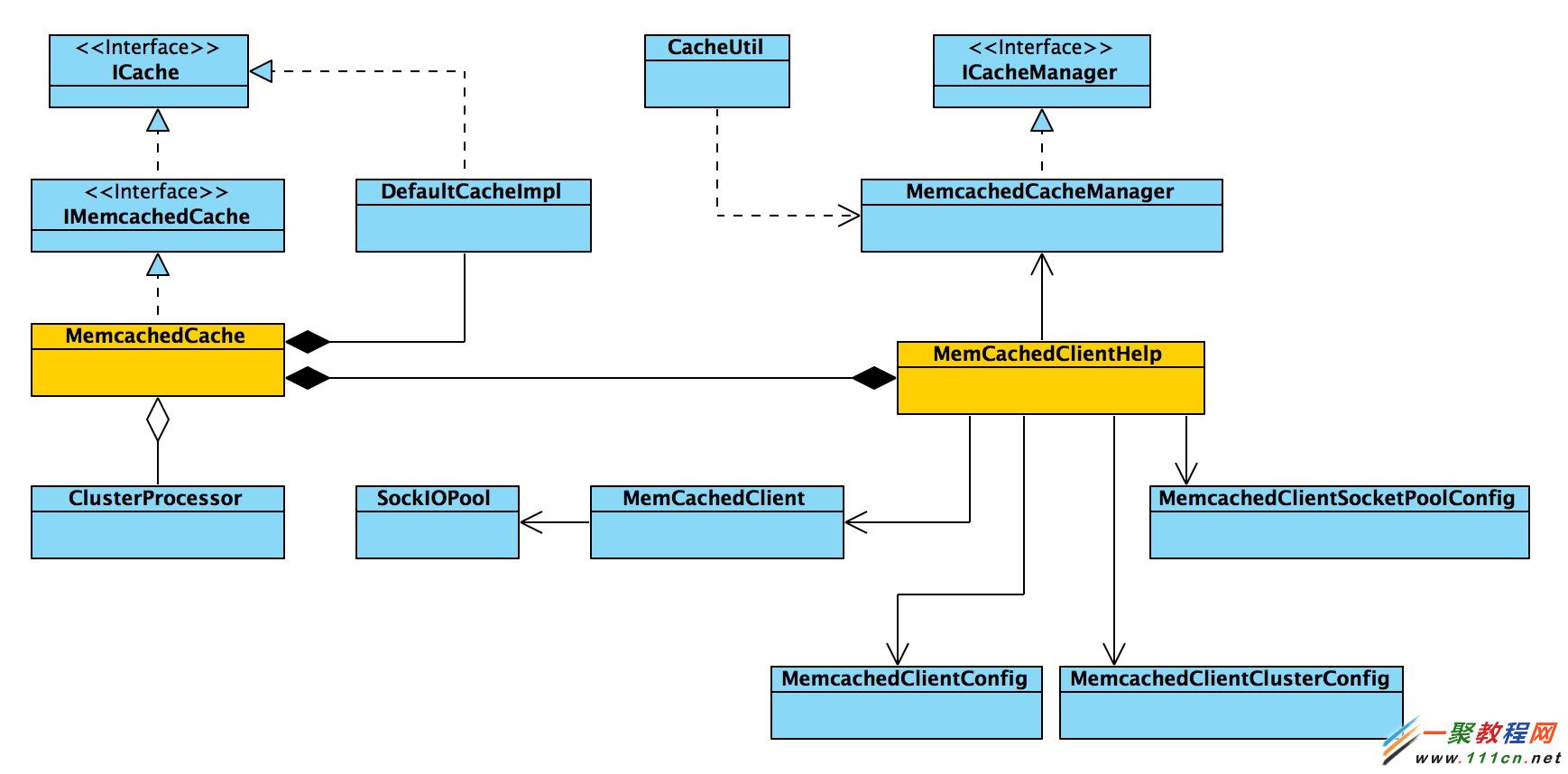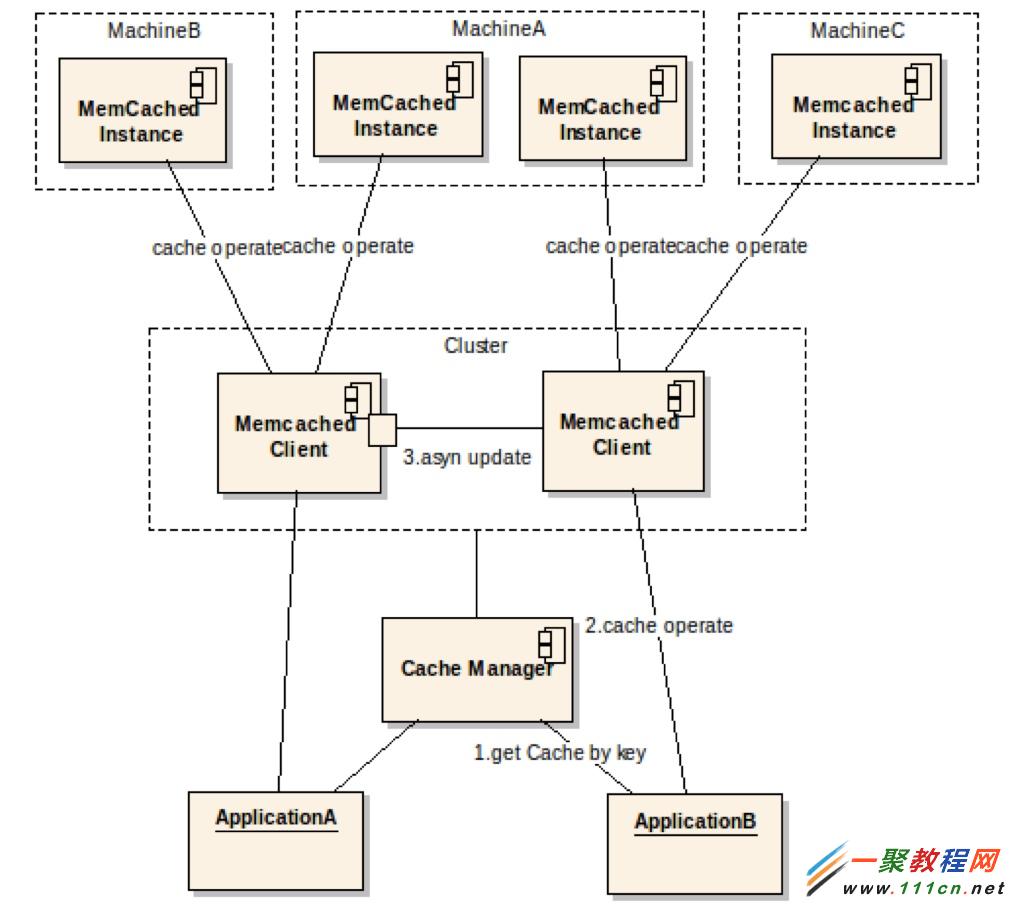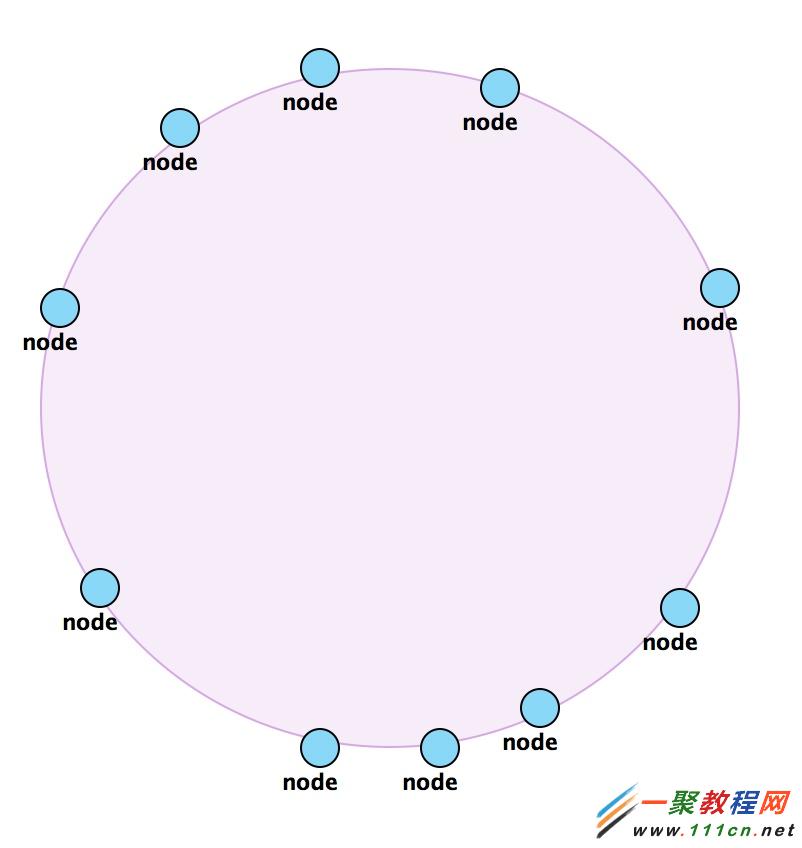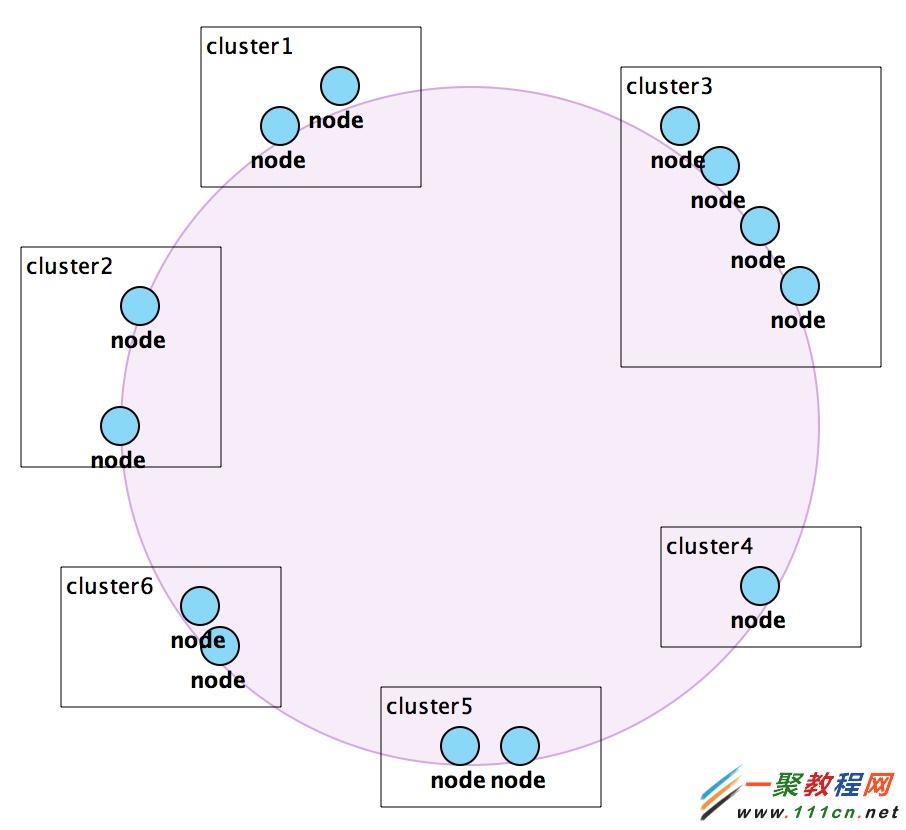阿里改造后的memcached客户端源码详解
源码分析
memcached本身是一个集中式的内存缓存系统,对于分布式的支持服务端并没有实现,只有通过客户端实现;再者,memcached是基于TCP/UDP进行通信,只要客户端语言支持TCP/UDP即可实现客户端,并且可以根据需要进行功能扩展。memchaced-client-forjava 既是使用java语言实现的客户端,并且实现了自己的功能扩展,下面这张类图描述了其主要类之间的关系。

几个重要类的说明:
MemcachedCacheManager: 管理类,负责缓存服务端,客户端,以及相关资源池的初始化工作,获取客户端等等
MemcachedCache:memcached缓存实体类,实现了所有的缓存API,实际上也会调用MemcachedClient进行操作
MemcachedClient:memcached缓存客户端,一个逻辑概念,负责与服务端实例的实际交互,通过调用sockiopool中的socket
SockIOPool:socket连接资源池,负责与memcached服务端进行交互
ClusterProcessor:集群内数据异步操作工具类
客户端可配置化
MemcachedCacheManager是入口,其start方法读取配置文件memcached.xml,初始化各个组建,包括memcached客户端,socket连接池以及集群节点。
memcached客户端是个逻辑概念,并不是和memcached服务端实例一一对应的,可以认为其是一个逻辑环上的某个节点(后面会讲到hash一致性算法时涉及),该配置文件中,可配置一个或多个客户端,每个客户端可配置一个socketPool连接池,如下:
| 代码如下 | 复制代码 | ||||
| 代码如下 |
复制代码 |
| |||
初始化过程
上文提及的MemcachedCacheManager,该类功能包括有初始化各种资源池,获取所有客户端,重新加载配置文件以及集群复制等。我们重点分析方法start,该方法首先加载配置文件,然后初始化资源池,即方法initMemCacheClientPool,该方法中定义了三个资源池,即socket连接资源池socketpool,memcachedcache资源池cachepool,以及由客户端组成的集群资源池clusterpool,这些资源池的数据结构都是线程安全的ConcurrentHashMap,保证了并发效率。将配置信息分别实例化后,再分别放入对应的资源池容器中,socket连接放入socketpool中,memcached客户端放入cachepool中,定义的集群节点放入clusterpool中。
注意,在实例化socket连接池资源socketpool时,会调用每个pool的初始化方法pool.initialize(),来映射memcached实例到HASH环上,以及初始化socket连接。
单点问题
memcached的分布式,解决了容量水平扩容的问题,但是当某个节点失效时,还是会丢失一部分数据,单点故障依然存在,分布式只是解决了数据整体失效问题,而在实际项目中,特别是GAP平台适应的企业级项目中,是不允许数据不一致的,所以对每一份保存的数据都需要进行容灾处理,那么对于定义的每个memcached客户端,都至少增加一个新客户端与其组成一个cluster集群,当更新或者查找数据时,会先定位到该集群中某个节点,如果该节点失效,就去另外一个节点进行操作。在实际项目中,通过合理规划配置cluster和client(memcached客户端),可以最大限度的避免单点故障(当所有client都失效时还会丢失数据)。在配置文件中,集群配置如下:
| 代码如下 | 复制代码 |
下图展现了扩容和单点故障解决方案:

HASH一致性算法
在memcached支持分布式部署场景下,如何获取一个memcached实例?如何平均分配memcached实例的存储?这些需要一个算法来实现,我们选择的是HASH一致性算法,具体就体现在客户端如何获取一个连接memcached服务端的socket上,也就是如何定位memcached实例的问题?算法要求能够根据每次提供的同一个key获得同一个实例。
HASH闭环的初始化
本质上,hash一致性算法是需要实现一个逻辑环,如图所示,环上所有的节点即为一个memcached实例,如何实现?其实是根据每个memcached实例所在的ip地址,将所有的实例映射到hash数值空间中,构成一个闭合的圆环。

HASH环映射的初始化的代码位于SocketIOPool.populateConsistentBuckets方法中,主要代码如下:
| 代码如下 | 复制代码 |
| private void populateConsistentBuckets() { ……... for (int i = 0; i < servers.length; i++) { int thisWeight = 1; if (this.weights != null && this.weights[i] != null) thisWeight = this.weights[i]; double factor = Math .floor(((double) (40 * this.servers.length * thisWeight)) / (double ) this.totalWeight); for (long j = 0; j < factor; j++) { byte[] d = md5.digest((servers[i] + "-" + j).getBytes()); for (int h = 0; h < 4; h++) { // k 的值使用MD5hash算法计算获得 Long k = ((long) (d[3 + h * 4] & 0xFF) << 24) | ((long) (d[2 + h * 4] & 0xFF) << 16) | ((long) (d[1 + h * 4] & 0xFF) << 8) | ((long) (d[0 + h * 4] & 0xFF)); // 用treemap来存储memcached实例所在的ip地址, // 也就是将每个缓存实例所在的ip地址映射到由k组成的hash环上 consistentBuckets.put(k, servers[i]); if (log.isDebugEnabled()) log.debug("++++ added " + servers[i] + " to server bucket"); } } ……... } } |
|
获取socket连接
在实际获取memcahced实例所在服务器的soket时,只要使用基于同一个存储对象的key的MD5Hash算法,就可以获得相同的memcached实例所在的ip地址,也就是可以准确定位到hash环上相同的节点,代码位于SocketIOPool.getSock方法中,主要代码如下:
| 代码如下 | 复制代码 |
public SockIO getSock(String key, Integer hashCode){ …………. // from here on, we are working w/ multiple servers // keep trying different servers until we find one // making sure we only try each server one time Set // get initial bucket // 通过key值计算hash值,使用的是基于MD5的算法 long bucket = getBucket(key, hashCode); String server = (this.hashingAlg == CONSISTENT_HASH) ? consistentBuckets .get(bucket) : buckets.g et((int) bucket); …………... } private long getBucket(String key, Integer hashCode) { / / 通过key值计算hash值,使用的是基于MD5的算法 long hc = getHash(key, hashCode); if (this.hashingAlg == CONSISTENT_HASH) { return findPointFor(hc); } else { long bucket = hc % buckets.size(); if (bucket < 0) bucket *= -1; return bucket; } } /** * Gets the first available key equal or above the given one, if none found, * returns the first k in the bucket * * @param k * key * @return */ private Long findPointFor(Long hv) { // this works in java 6, but still want to release support for java5 // Long k = this.consistentBuckets.ceilingKey( hv ); // return ( k == null ) ? this.consistentBuckets.firstKey() : k; // 该consistentBuckets中存储的是HASH结构初始化时,存入的所有memcahced实例节点,也就是整个hash环 // tailMap方法是取出大于等于hv的所有节点,并且是递增有序的 SortedMap // 如果tmap为空,就默认返回hash环上的第一个值,否则就返回最接近hv值的那个节点 return (tmap.isEmpty()) ? this.consistentBuckets.firstKey() : tmap .firstKey(); } /** * Returns a bucket to check for a given key. * * @param key * String key cache is stored under * @return int bucket */ private long getHash(String key, Integer hashCode) { if (hashCode != null) { if (hashingAlg == CONSISTENT_HASH) return hashCode.longValue() & 0xffffffffL; else return hashCode.longValue(); } else { switch (hashingAlg) { case NATIVE_HASH: return (long) key.hashCode(); case OLD_COMPAT_HASH: return origCompatHashingAlg(key); case NEW_COMPAT_HASH: return newCompatHashingAlg(key); case CONSISTENT_HASH: return md5HashingAlg(key); default: // use the native hash as a default hashingAlg = NATIVE_HASH; return (long) key.hashCode(); } } } /** * Internal private hashing method. * * MD5 based hash algorithm for use in the consistent hashing approach. * * @param key * @return */ private static long md5HashingAlg(String key) { / /通过key值计算hash值,使用的是基于MD5的算法 MessageDigest md5 = MD5.get(); md5.reset(); md5.update(key.getBytes()); byte[] bKey = md5.digest(); long res = ((long) (bKey[3] & 0xFF) << 24) | ((long) (bKey[2] & 0xFF) << 16) | ((long) (bKey[1] & 0xFF) << 8) | (long) (bKey[0] & 0xFF); return res; } |
|
通过以上代码的分析,整个memcahced服务端实例HASH环的初始化,以及数据更新和查找使用的算法都是基于同一种算法,这就保证了通过同一个key获得的memcahced实例为同一个。
socket连接池
这部分单独介绍,请猛烈地戳这里。
容灾、故障转移以及性能
衡量系统的稳定性,很大程度上是对各种异常情况的处理,充分考虑异常情况,以及合理处理异常是对系统设计人员的要求,下面看看在故障处理和容灾方面系统都做了那些工作。
定位memcached实例时,当第一次定位失败,会对所有其他的属于同一个socketpool中的memcahced实例进行定位,找到一个可用的,代码如下:
| 代码如下 | 复制代码 |
// log that we tried // 先删除定位失败的实例 tryServers.remove(server); if (tryServers.isEmpty()) break; // if we failed to get a socket from this server // then we try again by adding an incrementer to the // current key and then rehashing int rehashTries = 0; while (!tryServers.contains(server)) { // 重新计算key值 String newKey = new StringBuilder().append(rehashTries).append(key).toString(); // String.format( "%s%s", rehashTries, key ); if (log.isDebugEnabled()) log.debug("rehashing with: " + newKey); // 去HASH环上定位实例节点 bucket = getBucket(newKey, null); server=(this.hashingAlg == CONSISTENT_HASH) ? consistentBuckets.get(bucket) : buckets.get((int) bucket); rehashTries++; } |
|
查找数据时,当前节点获取不到,会尝试到所在集群中其他的节点查找,成功后,会将数据复制到原先失效的节点中,代码如下:
| 代码如下 | 复制代码 |
public Object get(String key) { Object result = null; boolean isError = false; ……....... if (result == null && helper.hasCluster()) if (isError || helper.getClusterMode().equals(MemcachedClientClusterConfig.CLUSTER_MODE_ACTIVE)) { List for(MemCachedClient cache : caches) { if (getCacheClient(key).equals(cache)) continue; try{ try { result = cache.get(key); } catch(MemcachedException ex) { Logger.error(new StringBuilder(helper.getCacheName()) .append(" cluster get error"),ex); continue; } //仅仅判断另一台备份机器,不多次判断,防止效率低下 if (helper.getClusterMode().equals(MemcachedClientClusterConfig.CLUSTER_MODE_ACTIVE ) && result != null) { Object[] commands = new Object[]{CacheCommand.RECOVER,key,result}; // 加入队列,异步执行复制数据 addCommandToQueue(commands); } break; } catch(Exception e) { Logger.error(new StringBuilder(helper.getCacheName()) .append(" cluster get error"),e); } } } return result; } |
|
更新数据时,异步更新到集群内其他节点,示例代码如下:
| 代码如下 | 复制代码 |
public boolean add(String key, Object value) { boolean result = getCacheClient(key).add(key,value); if (helper.hasCluster()) { Object[] commands = new Object[]{CacheCommand.ADD,key,value}; // 加入队列,异步执行 addCommandToQueue(commands); } return result; } |
|
删除数据时,需要同步执行,如果异步的话,会产生脏数据,代码如下:
| 代码如下 | 复制代码 |
public Object remove(String key) { Object result = getCacheClient(key).delete(key); //异步删除由于集群会导致无法被删除,因此需要一次性全部清除 if (helper.hasCluster()) { List for(MemCachedClient cache : caches) { if (getCacheClient(key).equals(cache)) continue; try { cache.delete(key); } catch(Exception ex) { Logger.error(new StringBuilder(helper.getCacheName()) .append(" cluster remove error"),ex); } } } return result; } |
|
异步执行集群内数据同步,因为不可能每次数据都要同步执行到集群内每个节点,这样会降低系统性能;所以在构造MemcachedCache对象时,会建立一个队列,线程安全的linked阻塞队列LinkedBlockingQueue,将所有需要异步执行的命令放入队列中,异步执行,具体异步执行由ClusterProcessor类负责。
| 代码如下 | 复制代码 |
public MemcachedCache(MemCachedClientHelper helper,int statisticsInterval) { this.helper = helper; dataQueue = new LinkedBlockingQueue ……… processor = new ClusterProcessor(dataQueue,helper); processor.setDaemon(true); processor.start(); } |
|
本地缓存的使用是为了降低连接服务端的IO开销,当有些数据变化频率很低时,完全可以放在应用服务器本地,同时可以设置有效时间,直接获取。DefaultCacheImpl类为本地缓存的实现类,在构造MemcachedCache对象时,即初始化。
每次查找数据时,会先查找本地缓存,如果没有再去查缓存,结束后将数据让如本地缓存中,代码如下:
| 代码如下 | 复制代码 |
public Object get(String key, int localTTL) { Object result = null; // 本地缓存中查找 result = localCache.get(key); if (result == null) { result = get(key); if (result != null) { Calendar calendar = Calendar.getInstance(); calendar.add(Calendar.SECOND, localTTL); // 放入本地缓存 localCache.put(key, result,calendar.getTime()); } } return result; } |
|
增加缓存数据时,会删除本地缓存中对应的数据,代码如下:
| 代码如下 | 复制代码 |
public Object put(String key, Object value, Date expiry) { boolean result = getCacheClient(key).set(key,value,expiry); //移除本地缓存的内容 if (result) localCache.remove(key); …….. return value; } |
|
改造部分
据以上分析,我们通过封装,做到了客户端的可配置化,memcached实例的水平扩展,通过集群解决了单点故障问题,并且保证了应用程序只要每次使用相同的数据对象的key值即可获取相同的memcached实例进行操作。但是,为了使缓存的使用对于应用程序来说完全透明,我们对cluster部分进行了再次封装,即把cluster看做一个node,根据cluster名称属性,进行HASH数值空间计算(同样基于MD5算法),映射到一个HASH环上,如下图,。

这部分逻辑放在初始化资源池clusterpool时进行(即放在MemcahedCacheManager.initMemCacheClientPool方法中),与上文中所描述的memcached实例HASH环映射的逻辑一致,部分代码如下:
| 代码如下 | 复制代码 |
| //populate cluster node to hash consistent Buckets MessageDigest md5 = MD5.get(); // 使用cluster的名称计算HASH数值空间 byte[] d = md5.digest((node.getName()).getBytes()); for (int h = 0; h < 4; h++) { Long k = ((long) (d[3 + h * 4] & 0xFF) << 24) | ((long) (d[2 + h * 4] & 0xFF) << 16) | ((long) (d[1 + h * 4] & 0xFF) << 8) | ((long) (d[0 + h * 4] & 0xFF)); consistentClusterBuckets.put(k, node.getName()); if (log.isDebugEnabled()) log.debug("++++ added " + node.getName() + " to cluster bucket"); } |
|
在进行缓存操作时,仍然使用数据对象的key值获取到某个cluster节点,然后再使用取余算法(这种算法也是经常用到的分布式定位算法,但是有局限性,即随着节点数的增减,定位越来越不准确),拿到cluster中的某个节点,在进行缓存的操作;定位hash环上cluster节点的逻辑也与上文一样,这里不在赘述。部分定位cluster中节点的取余算法代码如下:
public IMemcachedCache getCacheClient(String key){
………….
String clusterNode = getClusterNode(key);
MemcachedClientCluster mcc = clusterpool.get(clusterNode);
List
//根据取余算法获取集群中的某一个缓存节点
if (!memcachedCachesClients.isEmpty())
{
long keyhash = key.hashCode();
int index = (int)keyhash % memcachedCachesClients.size();
if (index < 0 )
index *= -1;
return memcachedCachesClients.get(index);
}
return null;
}
这样,对于应用来说,配置好资源池以后,无需关心那个集群或者客户端节点,直接通过MemcachedCacheManager获取到某个memcachedcache,然后进行缓存操作即可。
最后,使用GAP平台分布式缓存组件,需要提前做好容量规划,集群和客户端事先配置好;另外,缓存组件没有提供数据持久化功能。
相关文章
精彩推荐
-
 下载
下载疯狂医院达什医生中文版(Crazy Hospital)
模拟经营 疯狂医院达什医生中文版(Crazy Hospital)疯狂医院达什医生最新版是一款医院模拟经营类游戏,逼真的场景画
-
 下载
下载宝宝庄园官方版
模拟经营 宝宝庄园官方版宝宝庄园官方版是一款超级经典好玩的模拟经营类型的手游,这个游
-
 下载
下载桃源记官方正版
模拟经营 桃源记官方正版桃源记是一款休闲娱乐类的水墨手绘风格打造的模拟经营手游。玩家
-
 下载
下载长途巴士模拟器手机版
模拟经营 长途巴士模拟器手机版长途巴士模拟器汉化版是一款十分比真好玩的大巴车模拟驾驶运营类
-
 下载
下载房东模拟器最新版2024
模拟经营 房东模拟器最新版2024房东模拟器中文版是一个超级有趣的模拟经营类型的手游,这个游戏















